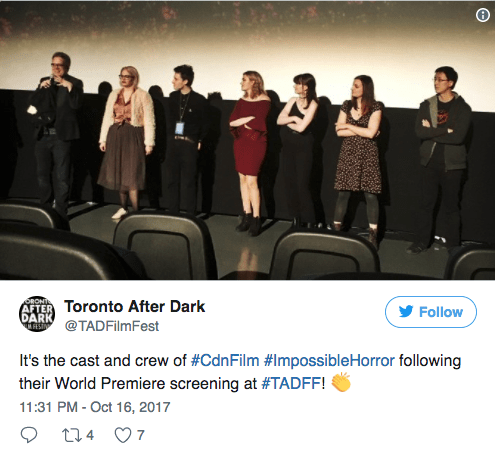
So much love for the World Premiere of Impossible Horror last night, we couldn’t believe it! Huge thanks to everyone that’s supported the film from conception to screening and we seriously can’t wait to get this bad boy released and out there for the world to see! Next screening is coming up at SF Indie’s Another Hole In The Head Film Festival on November 5, 2017 in San Francisco! If you’re in town check it out and let us know what you think!
We got a little excited and collected all the lovely tweets and instagram posts about Impossible Horror from our new fans! Check it out below!
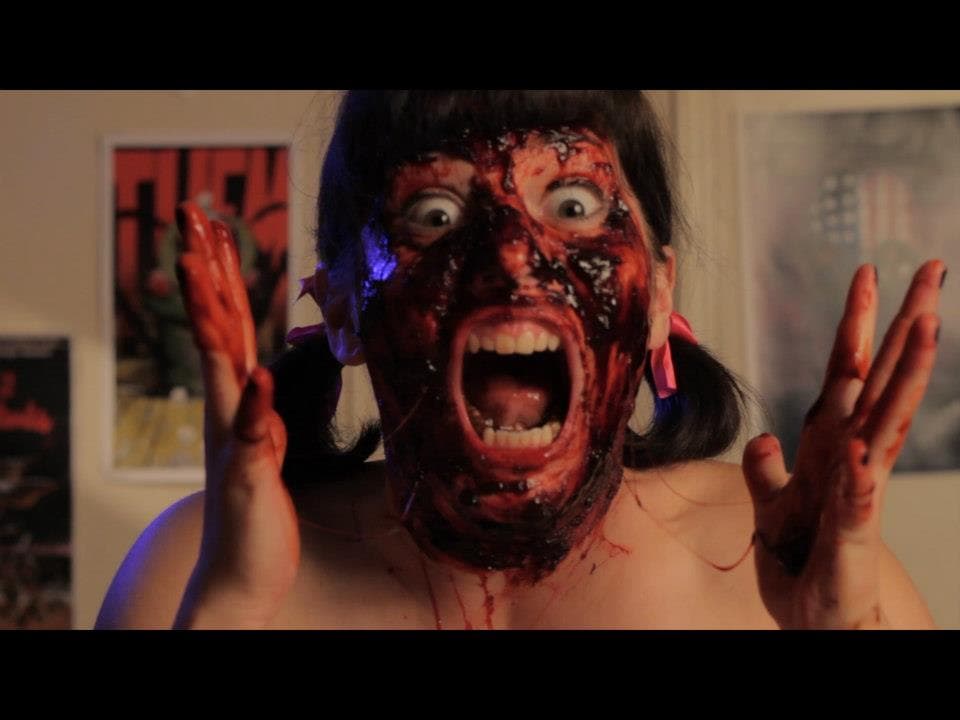
By Justin Decloux
We saved the best interview for last.
Hi! Director Justin Decloux here taking over the interviewing reigns from webmaster Emily Milling – who along with building this entire site was also the producer/scheduler/caterer/special effects artist/actress/sound designer/composer and a million other thing on IMPOSSIBLE HORROR. She would wake up, go to work for eight hours as a marketer, come home at six, and spend the rest of her night working on the film during shooting and then for the last eight months of post production!
I love Emily with all my heart and there is no way the project could have been completed without her hard work. She is one of the most multi-talented people I know and I thank the elder gods every day that I’m able to have her in my life.
Sheesh! Enough with the mushy stuff! Lets get to the her talking about how bloody difficult the project was to fight through! If you have your own questions about the film, get your tickets for the world premiere of Impossible Horror on Monday, October 16 at 9:30 p.m. at the Scotiabank Cinema to see the film and meet the cast & crew at the Q & A after the screening!
J: Did you get enough sleep last night?
E: No. I could use significantly more sleep!
J: I’m looking at the credits and did you actually do ALL OF THAT on those roles on the film!?
E: Yes. Producer, composer, sound design/mixing/foley, transportation, craft services, makeup and effects… you know, the stuff that needs to get done to make a film! But as a producer I was happy to take on the other random things even if I had no idea what I was doing. I did however, elect to do the sound myself which I’m kicking myself for now – I had no idea how difficult that would be. But maybe that’s the beauty of naïvety, when you don’t know what the hell is going on and you don’t know how long it will take, it’s a lot easier to keep plugging away until you do!
J: That’s crazy. What was the most difficult part of shooting?
E: Trying to make special effects, I think. I’m a perfectionist and I really like things to look slick but I’m not trained in effects at all so I had to rely on a lot of internet tutorials, most times, the day of the shoot when they’d be happening. There was a throat slit scene that ended up being cut (HA! PUN!) because I made the actor’s neck look like a pile of bloody toilet paper. I’m sure she loved that. It was also difficult to shoot midnights, of course, but when you’re running on pure adrenaline to get shit done, it gets easier. I also love to have everything planned down to the minute and I learned very quickly to be flexible with that, but it was a tough thing to move through.
J: What was the part you enjoyed the most?
E: Working with YOU! I think I liked pre-production the most because it involves so much planning and organization which I love, and I can be idealistic about how things will turn out. Then in productions my organizational dreams crash to the depths of hell, and in post I can ride everything out and accept that all the planning was actually really worthwhile. I also really enjoyed working with the tight-knit team, honestly
Haley and
Cree made the process so much easier just by being so professional and upbeat!
April continued to inspire me throughout the process with her “get it done!” attitude and gave me honest feedback when I needed it most, and
Nate and
Aidan were always supportive and hardworking throughout the process.
J: How did you approach the task of writing the music?
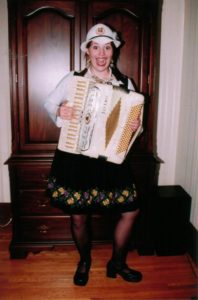
E: I spent a lot of time listening to a lot of music and tried to develop a sonic landscape to build from. I made a
playlist to inspire me! Lots of Tangerine Dream, the soundtrack for Stranger Things (obviously, because that’s what everyone’s going to be drawing inspiration from right now), Cliff Martinez, Mark Korven, John Carpenter – you know the drill. I’m always bummed when I look at that list and realize there are no women on it.
Back to process. When I get overwhelmed by giant tasks (like writing 18 cues that need to connect and bridge scenes and emotions together) I tend to look at a lot of different types of sounds and download way too many free plugins so that I can listen to all the presets and pretend I’m working really hard and being productive. In the end I forced myself to pick a few instruments I really liked, and I built out themes from there.
One thing I’m really happy with is this concept of sparse drumming that was inspired by
Mark Korven’s The Witch OST. He’s got this
crazy cool instrument he had custom built to make all the super neat organic sounds you can hear in those pieces, as well as a waterphone (someone please buy me one!) and all I had to use was my computer and a couple of pencils I whacked against my desk a lot. I love listening back to the unaffected pencils, or “sticks” as we affectionally call them in the Milling/Decloux household and just how terrible I am with rhythm, and how I was able to use the magic of technology to make them sound like this weird ethereal and suspenseful glue that tied everything together.
J: How do you make the cues feel like they’re all part of a whole?
E: I listened back to my music a lot in the car on the way to work every single day. Any time I’d write a new piece, I’d listen through to all of the tracks together as though I was trying to build an album. Hearing the nuances I’d placed in each track helped guide themes in other pieces. Little riffs here and there with a particular synth sound I liked would reappear later as the main driving theme in later tracks, and vice versa as I moved through the film. Keeping a set list of the instruments I wanted to use really helped as well – because man you can go down wormholes of free VSTs until the cows come home. WOO!
J: How do you find inspiration for sound design?
E: I was pretty lucky that the new Twin Peaks came out RIGHT as I was getting into it. I had finished all the foley and finding the majority of sound effects at that point, and couldn’t figure out why things felt so sparse and incomplete. Then episode 8 of Twin Peaks season 3 came out and I was like OH YEAH I GET IT NOW! I also re-watched Eraserhead here and there to understand David Lynch’s brain a bit better, and how he found those sounds.
I have this memory of being a really angsty teenager on a trip to Newfoundland with my grandparents in about grade 10, and we were on the ferry crossing over to the island. My brain was going a zillion miles an hour (hooray for undiagnosed ADHD!) and the sound the ferry was making was so overwhelming and all encompassing, it was this huge engine sound, a droning sound, and it reverberated all over the ship so I could feel it everywhere. That sound calmed me down a lot and I always thought “I wish I could just hear this and be calm all the time,” and that feeling drove a lot of the more intense scenes, like towards the end when Hannah and Lily are in the parking garage. I recorded the giant sound reverberating all over the parking garage in our building (where we shot the film) and added in a bit of a wavering bass sound using an LFO in Ableton to achieve that. I guess it’s a little weird that I went in the opposite direction, using calming sounds to create intense feelings, but I think it worked in my favour!
J: What was the toughest sound to get?
E: Creating the cacophony of sounds in the playground when Hannah and Lily find the saxophone and they’re confronted by the mysterious hoodie figures was ridiculously difficult. I literally hated it. And I still hate it. But I’m told it’s fine so I’m going to just leave it at that!
J: How does it feel that the project is almost over?
E: It is?!?!?! I feel so great. I’m so exhausted but I seriously feel so great. I’m so proud of the work that everyone put in, and I’m proud of the work that I put in too. I lived for a long time not making films, being intimidated by it even though it’s all I want to do, and being able to pour myself into this project drew it out of me. I feel way more confident about my capabilities as a filmmaker, being on set taught me a lot and pushed my boundaries a lot, taught me to not be so afraid. I talk to other women in film/media and I hear my own story echoed all the time, we’re always getting shut down & losing confidence. That’s really shitty. I’m glad I had the opportunity to grow in this art in a really productive, supportive environment with you and the team, I’d do it over again in a heartbeat! I hope that from this I can take my confidence and help champion the other amazing women in film in Toronto!
J: What would do differently next time?
E: So many things! But that’s just because I learned how to do almost all of this along the way. I would definitely work with a bigger budget next time to allow for a bigger team, we really did a lot with next to no budget which just meant that you and I (and everyone on set) filled a lot of different roles. I’d like to have the money to hire more people next time, so that we can stick to creative vision and process with a great team to help support execution.
J: I look forward to seeing your next project!
E: And I look forward to seeing yours!
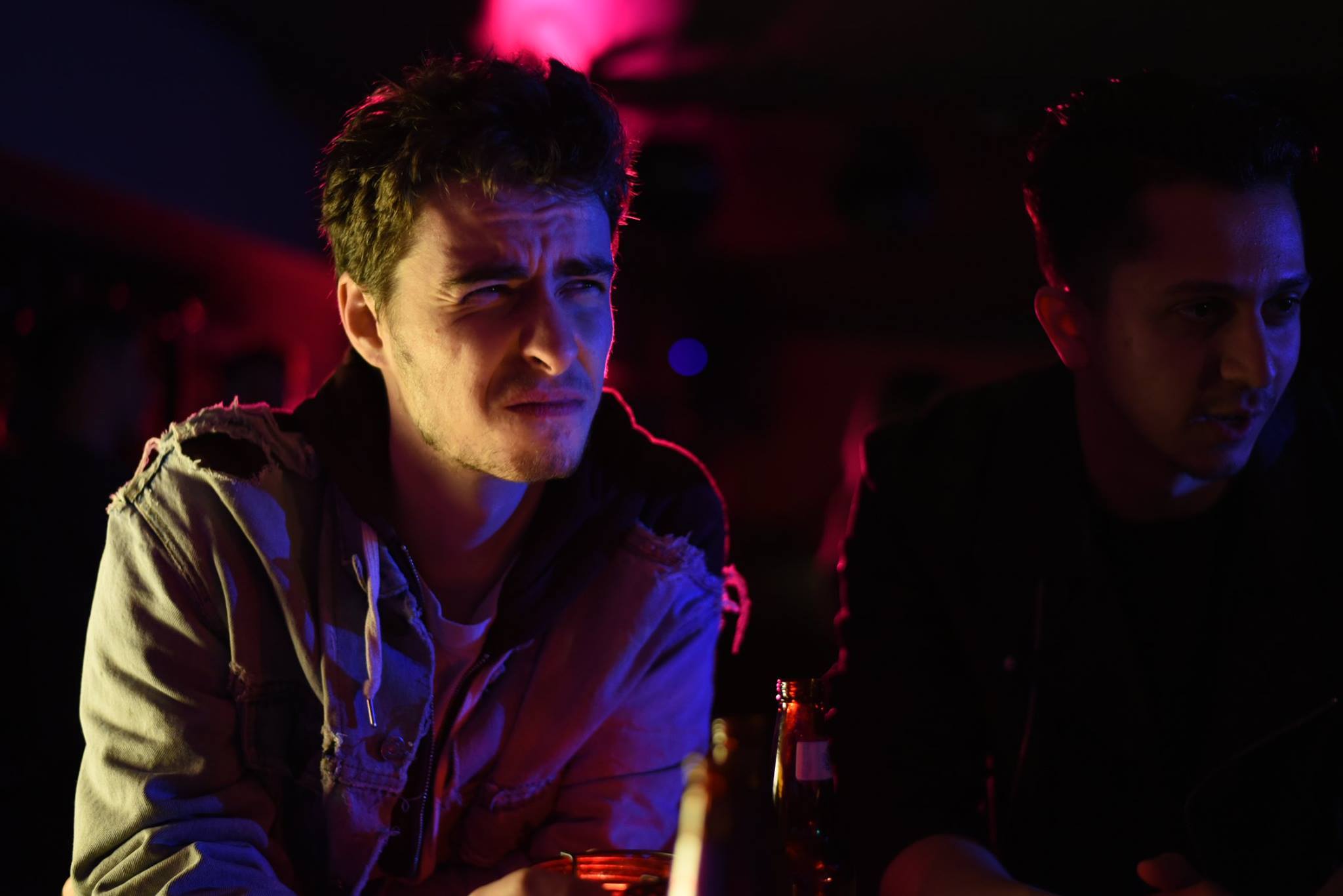
By Emily Milling
You may know Nate Wilson – Writer Producer from such films as Fuck Buddies, or Bonfire, which premieres tonight at the Toronto After Dark Film Festival. Nate’s a filmmaker with a strong creative vision and the determination to get things done. On Impossible Horror, Nate wrote along with director Justin Decloux, and produced along with me, to help make the film as creative and original as it is. Check out Bonfire at 4:00 p.m. at the Scotiabank Theatre on Sunday, October 15 (playing before Rabbit) and follow it up with Impossible Horror on Monday at 9:30 p.m. on October 16!
E: Hey Nate!
N: Hel-
E: GROOVY! So let’s talk about Impossible Horror, your first feature film as a writer/producer. What was it about this project that drew you in?
N: I guess I had just finished writing and directing two thingies one after the other and thought the momentum would be great carrying over to a feature. The dream of making a super uninhibited low-budget horror movie has been the most prominent one in my life, and that’s not me being facetious or anything. So one day shortly after you and Justin started the Indiegogo we started talking like we often do. Then, as the Indiegogo continued, Justin and I began to write the script in the Toronto Reference Library. The moment presented itself and we all took it.
E: You worked very closely with Justin Decloux (writer/director) to develop the characters Lily and Hannah. Do you think your working dynamic is reflected in theirs? How so? If not, why?
N: I don’t think we intended for the working dynamic to be similar to us, but there’s probably something there. I think Justin and I were reflecting our worst creative selves from past projects to write Lily, and even then it was really easy for us both to become that person again. Lily and Hannah embody two opposing approaches to productivity that are hard to balance with each other. Neither way is wrong really, I hope we didn’t finish the movie too much as one or the other.
E: Impossible Horror deals with a lot of paranormal entities, can you talk a bit about creating the mythology behind the hoodies, and what the numbers mean on the objects that Lily and Hannah find?
N: The numbers are the order in which the objects were found, from object #1 to whatever the last one is. The order Hannah has is probably all wonky though. Justin and I figured out the mythology going from scene #1 to whatever the last one is, and that order’s probably wonky too.
E: Creative blocks are a running theme throughout the film. Eventually, Lily starts to get over her creative block by hunting the scream and developing a story for a film. What methods do you use to get over your creative blocks? Do you see any similarities between you and Lily in your methods?
N: I like to read, and walk around, and watch movies. I find I’ll get hit with stuff when I start doing something else. I definitely don’t like to stressturbate as much as Lily does, but maybe when I was younger.
E: What was the most difficult part of writing Impossible Horror, and how did you work through it?
N: When we had to rewrite the movie in two days and then I ate a convenience store roti and got so sick I was shitting and puking all night with the computer in the bathtub next to me. I think I took some pepto.
E: What did you enjoy most about working with the tight-knit cast and crew over the two weeks of midnight shoots?
N: Uhhhhhhhh. I mean don’t get me wrong, I enjoyed the whole thing, but I can’t really remember any details. Sometimes I would go to work in the day and we would start shooting at 7:00 p.m. every night and go till dawn. We all got super used to the smell of each other’s coffee farts and took our fair share of involuntary naps, and what can I say – a lot of us started getting pretty green by the end. But seriously, don’t get the wrong idea here, it was a total dream and everyone was a beautiful angel and I’ve never worked on a funner set with more professional people. I’d replicate the model in a heartbeat.
E: When the film started coming off the page, into life, what scene was the most exciting for you to watch as a writer?
N: I’m not sure what single scene. Watching the whole thing come together in the last couple months in editing has been a beautiful, beautiful experience. Every scene was out of context for so long that you forget these things were written to fit together. I don’t know when it was, but when you make a movie there is a moment when everything goes vertical, and it clicks in your brain, and it never really catches you by surprise cause you’ve been working on it for so long but it’s really nice. Sound design really does it usually, because your movie can be stick figures who barely move but when we hear a rich sound design it turns real. It’s such a magic trick.
E: Why should people come out to see Impossible Horror?
N: It’s heartfelt, and inventive, and relentless. It has great sound design. It’s the real deal!
E: Thanks Nate! Have a superb day!
N: Thanks Emily. We didn’t have to do this but we did, and we worked real hard and I think it was so worthwhile! I’m gonna go do my laundry.

By Emily Milling
Creedance Wright plays Hannah in Impossible Horror, a supremely daring and badass character, much like Creedance (Cree) herself. I asked Cree a few questions about her experience on the film, which will have its world premiere at Toronto After Dark Film Festival on October 16, 2017 at 9:30 p.m.
E: Hey Cree! What’s the haps?
C: Nothing new to report.
E: Thanks for taking the time to talk about your experience on Impossible Horror!
C: Of course, it’s my pleasure.
E: So you came onto the Impossible Horror project just after we had started production, and you took on the role of Hannah. What was it like to join a project already in progress and how did you get up to speed so quickly with your character?
C: It was pretty exciting to join a project already in the works, it meant I didn’t have to worry too much about any pre-production stuff, and I was just thrown right into the nitty gritty. Catching up wasn’t too difficult as long as I didn’t overthink anything, just listen to direction and try to read the script as quickly as humanly possible.
E: Had you trained previously for the action scenes you were asked to do? How did you prepare?
C: No previous training as far as actual fight choreography goes. Preparation ended up boiling down to just listening as carefully as I could to Alex and the other fight choreographers, taking things half speed when needed and always being aware of where the camera was to make sure everything looked good.
E: And what was it like to work with fight choreographer Alex Chung on the action sequences?
C: The scenes with Alex were the most exciting to film, those guys made me look good by really selling all the punches and kicks. Certainly made me look a hell of a lot tougher than I actually am.
E: What would you do to prepare each night before filming? Did you have any techniques you’d use to warm up?
C: I think the only consistent preparation was making sure I was actually getting enough sleep during the day so I could stay awake all night. I think as soon as I got to apartment every night during the bulk of filming I got into “shooting mode,” so really just getting into that mindset of (attempting) to be as professional as possible.
E: You’ve been extremely dedicated to Impossible Horror from the get-go, helping out with the crowdfunding campaign, coming in to re-record lines, even making sure that your character’s continuity was always on point. What does being part of this project mean to you?
C: This project means quite a bit to me as I’ve been on several film sets before, but always in the periphery, whereas on this set I truly felt like a part of the team. It was exciting to be working with people who I trusted, whose work I had seen and enjoyed in the past and have them also trust in me to perform. Plus who doesn’t love staying awake all night and slowly losing their mind!
E: What was the hardest thing you faced during the shoot and how did you overcome it?
C: I think first adjusting to the sleep schedule was the most difficult thing to get used to, and then just attempting to push through the bout of exhaustion that would inevitably come every night. That along with trying to stay on task when everyone was delusionally tired was probably the most difficult thing to overcome.
E: What was your favourite scene to shoot? And what was your least favourite? Why?
C: My favourite scene to shoot was the playground scene with Alex, and all the other stunt choreographers. It was certainly the most badass I felt on set. For me the worst scene was shooting the climax, only because it was so damn sticky. Along with the fact that we shot it after the bulk of shooting so I think I was out of that “shooting mindset” and the idea of filling my hair with oatmeal and black goo was no longer exciting.
E: What was the best experience you had on set?
C: Showering after shooting the climax. Seriously, it was so fucking sticky. But also most nights were a ton of fun, and full with laughs and a lot of screams.
E: Thank ya kindly, Cree! Have a marvellous day!
C: No problem!
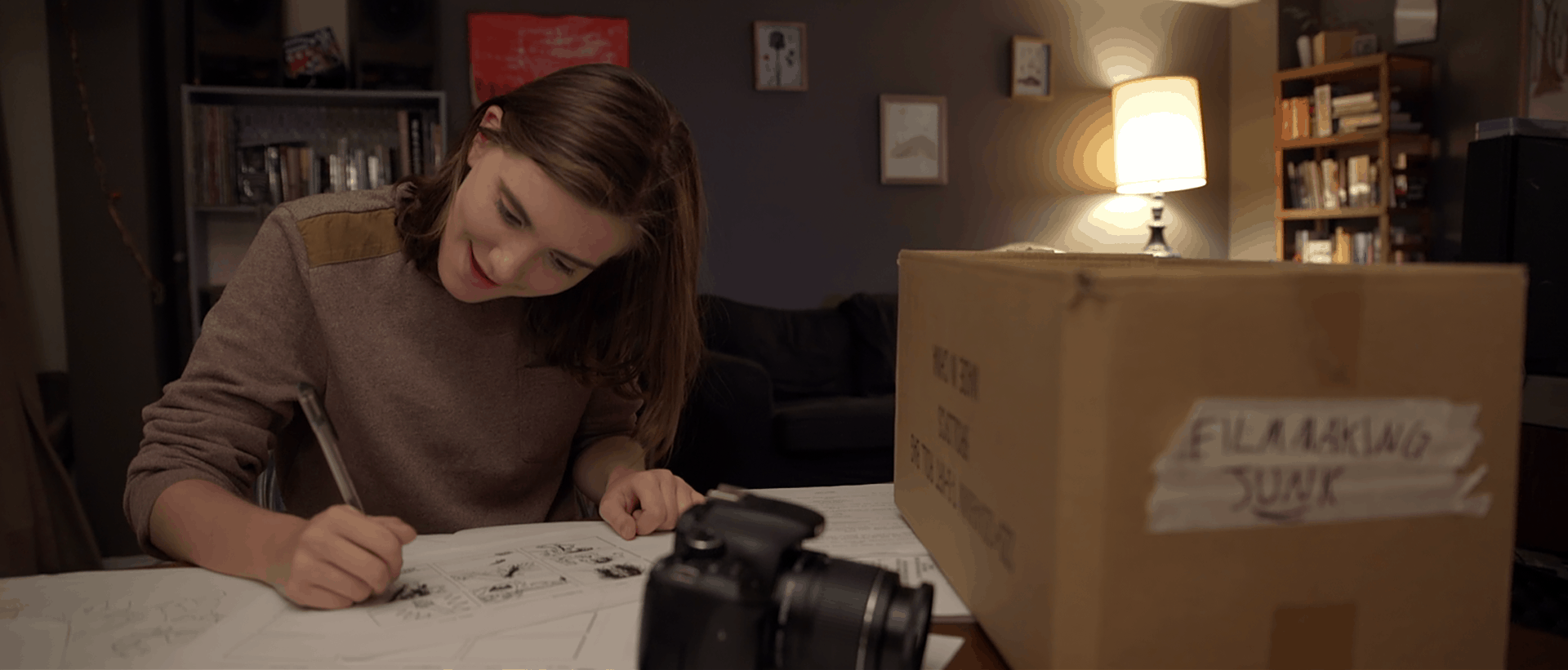
By Emily Milling
What would you do if someone saw you in a play, asked you out for Affogato and offered you a part in an indie horror film? That’s what happened to actor, Haley Walker, who plays Lily in Impossible Horror which will have its world premiere at Toronto After Dark Film Festival on October 16, 2017 at 9:30 p.m. To get into her story, I wanted to interview Haley Walker about her experience with the film from start to finish, and how she developed the process to create Lily and keep her consistent throughout production.
E: Hi Haley, how’s it going?
H: Pretty good Emily!
E: So you were brought into Impossible Horror towards the end of pre-production as an actor playing the role of Lily. Can you tell our dear readers how you came to be involved with the film and what your first thoughts were when you read the script?
H: Well it was Nate (writer and producer) who first approached me with the role. We knew each other from high school, I was doing a play in the Toronto Fringe at the time and he came to see one of my shows. After the show he came up to talk to me and pitched the idea. We went to a cafe, got Affogato, sat in Trinity Bellwoods park for a long time…we talked for so long! He told me everything! I felt like this project was a big deal. When I first read the script I was like, whoaaaaa…this is unlike anything I’ve done before. I had never done a horror movie.
E: Do you think that you and Lily have any similarities? What are they? What are the big contrasts between you and your character?
H: Lily feeds off of the art that inspires her. I totally relate to that. I need creative outlets, too! She likes to bury herself in it, it’s like her energy source. There’s almost always a movie playing in her apartment, much like how I’m almost always listening to music. Sometimes I lose meaning in an album I love or a book I’m reading and it’s hard to get back into it. I feel disconnected, it’s like I’ve lost a bit of myself. But then I find something new, attach myself to that, and then after a while I can go back to where I was before and find new meaning where I couldn’t previously. I think Lily goes through a similar process. But I think she’s more gutsy than I am. She gets pushed to the point of exploring these things that haunt her, and she enjoys it. I couldn’t do that. If something was haunting me, I’d run away.
E: How did you begin to build out the character of Lily before we got to set? What techniques did you use to prepare? OR How did you build out the character of Lily throughout the shoot? What techniques did you use to prepare for filming each day?
H: I did a lot of staring at myself in the mirror, practicing facial expressions and saying lines. I do this a lot, actually. I talk to myself a bunch when I’m alone.
E: We shot the film over about a year and a half, and recorded some ADR and extra lines for your character here and there as it developed. How did you keep Lily consistent throughout this long timeframe? Even last month we had you in to record a few new lines – what did you do to get back into the Lily headspace?
H: This was so hard. Oh my god. Conversation with the director was super important for me & my process. There wasn’t much that I could do beforehand, just being in the space where we were shooting was what helped me. The fact that we did ADR and other sound stuff in the same apartment where we shot a lot of it was good for keeping me consistent. We’d always meet in that apartment regardless of where we were shooting, so I’d get into costume and do my makeup there. I became Lily in there every day. Just being in it brings me back to her.
E: Now that we know how you work – fill us in on what it was like for you to perform with the mental constraints of working in the middle of the night for two and a half weeks?
H: Wild. Just wild. I am not one for pulling all nighters anymore, at the time it wasn’t as hard as it is for me now. It was still hard though. I remember being totally content with napping on a cold, hard floor. That process was my first time working on a feature and also working with a cast & crew that doesn’t consist of my old friends or classmates, so I got early exposure to a different and, in some ways, more difficult process!
E: What was the hardest thing you faced during the shoot and how did you overcome it?
H: It was very hard to stay focused when everyone is running on a lack of sleep and we’re seeing each other basically every day for weeks straight. It got loopy. We all got loopy. There’s not much you can do in a situation like that besides check out after leaving the set. Leave it at the set and come back to it later, don’t take it with you. Even that was hard to do, but you do your best. And we had days off so I’d just relax on those days.
E: What was your favourite scene to shoot? And what was your least favourite? Why?
H: My favourite scene to shoot was the first scene where Lily and Hannah meet. It was really exciting to shoot! All the running scenes and fighting scenes were so fun. My least favourite scene to shoot was probably that creepy doll scene, where everything in the apartment starts moving. That one was done in one shot and the doll kept falling over, I was so annoyed.
E: There’s a pretty significant dynamic and character shift in Lily from the start of the film to the end which is remarkable to watch on screen, it’s almost as if Lily becomes a completely different person. Can you walk us through the choices you made to bring Lily to such a dark place?
H: Well I think a lot of it came from outside factors. Despite shooting scenes out of chronological order, the jumps in time weren’t too drastic which helped me stay in touch with Lily’s transformation. The very first scene in the movie was the first scene we shot, and the very last scene was one of the last scenes we shot, so by that time I had been through so much. I had become comfortable in the apartment, comfortable with the cast & crew, I knew the story well…I had spent so much time with this film. I had time to get comfortable with Lily which made playing the shift easier. Plus, I was running on a messed up sleep schedule and my diet consisted of mostly bagels, so that definitely changed something in me. As I grew and changed, so did Lily.
E: What was the best experience you had on set?
H: Getting absolutely soaked in goo, blood, and whatever else you guys threw on me. I really love getting down and dirty for a film. And you guys were always very professional and adamant about health & safety so I felt comfortable!
E: Thanks, Haley! It was lovely to speak with you today! Regards!
H: Always a pleasure, Emily!





